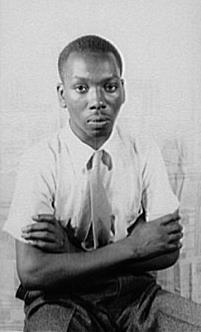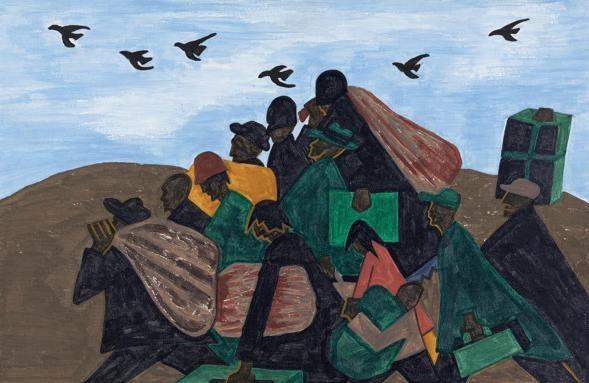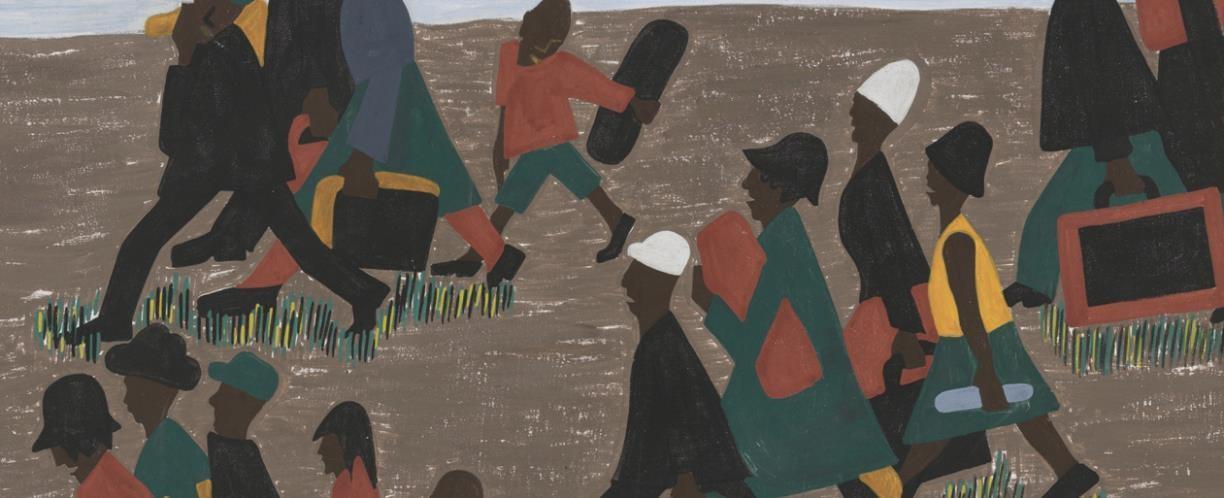Jacob Armstead Lawrence
Lawrence gained national recognition with his sixty panel Migration Series, painted on cardboard. The series depicted the Great Migration of African Americans from the rural South to the urban North. A part of this series was featured in a 1941 issue of Fortune.
Lawrence’s works are in the permanent collections of numerous museums in the USA, including the Philadelphia Museum of Art, the Museum of Modern Art, the Whitney Museum, the Phillips Collection, Metropolitan Museum of Art, the Brooklyn Museum, and Reynolda House Museum of American Art.
1917
2000
America
American
Lawrence was born on 7 September 1917 in Atlantic City, New Jersey. He was the eldest child of Jacob and Rosa Lee Lawrence. The senior Lawrence worked as a railroad cook and in 1919 moved his family to Easton, Pennsylvania, where he sought work as a coal miner. Lawrence’s parents separated when he was seven, and in 1924 his mother moved her children first to Philadelphia, and then to Harlem when Jacob was twelve years old. He enrolled in Public School 89 located at 135th Street and Lenox Avenue, and also at the Utopia Children’s Centre. This was a settlement house that provided an after school programme in arts and crafts for Harlem children. The Centre was operated at that time by painter Charles Alston who immediately recognized young Lawrence’s talents.
Shortly after he began attending classes at Utopia Children’s Centre Lawrence developed an interest in drawing simple geometric patterns and making diorama type paintings from corrugated cardboard boxes. Following his graduation from Public School 89, Lawrence enrolled in Commerce High School on West 65thStreet and painted intermittently on his own. As the Depression became more acute, Lawrence’s mother lost her job and the family had to go on welfare. Lawrence dropped out of high school before his junior year to help support his family. He enrolled in the Civilian Conservation Corps, a New Deal jobs programme, and was sent to upstate New York. There he planted trees, drained swamps, and built dams. When Lawrence returned to Harlem he became associated with the Harlem Community Art Centre directed by sculptor Augusta Savage, and began painting his earliest Harlem scenes. Lawrence enjoyed playing pool at the Harlem YMCA where he met `Professor’ Seifert, a Black, self-styled lecturer and historian who had collected a large library of African and African American literature. Seifert encouraged Lawrence to visit the Schomburg Library in Harlem to read everything he could about African and African American culture. He also invited Lawrence to use his personal library, and to visit the Museum of Modern Art’s exhibition of African art in 1935.
As the Depression continued, circumstances remained financially difficult for Lawrence and his family. Through the persistence of Augusta Savage, Lawrence was assigned to an easel project with the Works Progress Administration (WPA). Lawrence became interested in the life of Toussaint L’Ouverture, the Black revolutionary and founder of the Republic of Haiti. He felt that a single painting would not depict L’Ouverture’s numerous achievements, and decided to produce a series of paintings on the General’s life.
Lawrence is known primarily for his series of panels on the lives of important African Americans in history, and scenes of African American life. His series of paintings include: The Life of Toussaint L’Ouverture, 1937, (forty one panels), The Life of Frederick Douglass, 1938, (forty panels), The Life of Harriet Tubman, 1939, (thirty one panels), The Migration of the Negro,1940 – 41, (sixty panels), The Life of John Brown, 1941, (twenty two panels), Harlem, 1942, (thirty panels), War, 1946 – 47, (fourteen panels), The South, 1947, (ten panels), Hospital, 1949 – 50, (eleven panels), Struggle? History of the American People, 1953 – 55, (thirty panels completed, sixty projected).
Lawrence’s best known series is The Migration of the Negro, executed in 1940 and 1941. The panels portray the migration of over a million African Americans from the South to industrial cities in the North between 1910 and 1940. These panels, as well as others by
Lawrence, are linked together by descriptive phrases, color, and design. In
November 1941 Lawrence’s Migration series was exhibited at the prestigious Downtown
Gallery in New York and received wide acclaim. At the age of twenty four
Lawrence became the first African American artist to be represented by a mainstream gallery. During the same month Fortune magazine published a lengthy article about Lawrence, and illustrated twenty six of the series’ sixty panels. In 1943 the Downtown Gallery exhibited Lawrence’s Harlem series, which was lauded by some critics as being even more successful than the Migration panels.
In 1937 Lawrence obtained a scholarship to the American Artists School in New York. At about the same time, he was also the recipient of a Rosenwald Grant for three consecutive years. In 1943 Lawrence joined the US Coast Guard and was assigned to troop ships that sailed to Italy and India. After his discharge in 1945, Lawrence returned to painting the history of African American people. In the summer of 1947 Lawrence taught at the innovative Black Mountain College in North Carolina at the invitation of painter Josef Albers.
During the late 1940s Lawrence was the most celebrated African American painter in America. Young, gifted, and personable, Lawrence presented the image of the Black artist who had truly arrived. Lawrence was, however, somewhat overwhelmed by his own success, and deeply concerned that some of his equally talented Black artist friends had not achieved a similar success. In July 1949 he voluntarily entered Hillside Hospital in Queens, New York, to receive treatment for depression. He completed the Hospital series while at Hillside.
Following his discharge from the hospital in 1950, Lawrence resumed painting . In 1960 he was honoured with a retrospective exhibition and monograph prepared by the American Federation of Arts. He also travelled to Africa twice during the 1960s and lived primarily in Nigeria. Lawrence taught for a number of years at the Art Students League in New York, and also served on the faculties of Brandeis University, the New School for Social Research, California State College at Hayward, the Pratt Institute, and the University of Washington, Seattle.
In 1974 the Whitney Museum of American Art in New York held a major retrospective of Lawrence’s work that toured nationally, and in December 1983 Lawrence was elected to the American Academy of Arts and Letters. A retrospective of Lawrence’s paintings was organized by the Seattle Art Museum in 1986, and was accompanied by a major catalogue. Lawrence met his wife Gwendolyn Knight, a fellow artist, when he was a teenager. They were married in 1941, and their close and mutually supportive relationship has been an important factor in Lawrence’s career. They were married until his death in 2000.
;
https://www.apollo-magazine.com/powerful-humbling-and-relevant-jacob-lawrencesmigration-series-at-moma/
https://americanart.si.edu/artist/jacob-lawrence-2828
https://en.wikipedia.org/wiki/Jacob_Lawrence
https://www.dcmooregallery.com/artists/jacob-lawrence





